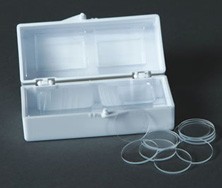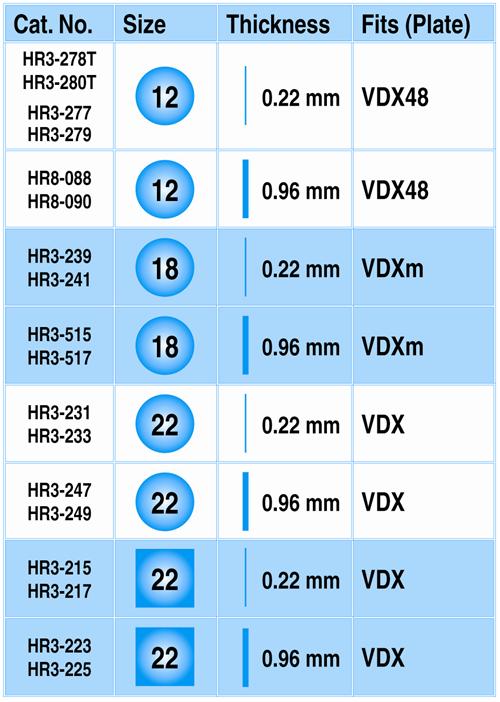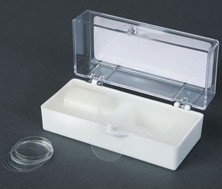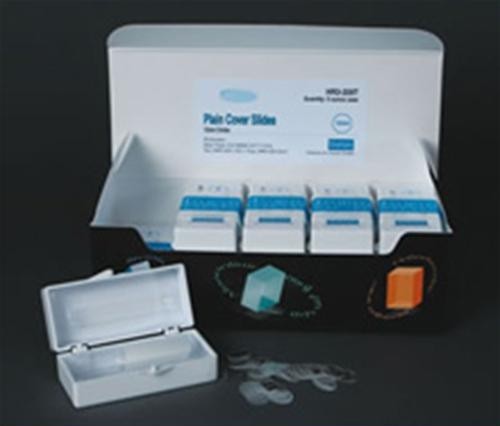Hampton Siliconized Glass Cover Slides
ApplicationsHanging, sitting or sandwich drop crystallization
FeaturesHigh purity of glassSiliconized, hydrophobic glass surface0.22 mm & 0.96 mm glass thicknessThicker glass slides preserve temperature longer12 mm, 18 mm, & 22 mm glass diameterCircle & squareUV Compatible (>85% transmission)
12 x 0.22 mm Circle
18 x 0.22 mm Circle
22 x 0.22 mm Circle & Square
Description
Siliconized glass cover slides allow a droplet to be suspended in a position which provides near optimal conditions for vapor diffusion with the surrounding reservoir solution. These siliconized glass cover slides provide a consistent, high quality finish for crystallization experiments. The hydrophobic surface produces a drop which “stands well” and does not flatten on the glass. The siliconized surface prevents the adhesion of crystals and precipitate onto the glass surface. Use Dow Corning Vacuum Grease (HR3-510), Dow Corning 7 Release Compound (HR3-508), or immersion oil to seal cover slide to plate. Available in 12, 18 or 22 mm diameter circles and 22 mm diameter squares. Available in 0.22 mm or 0.96 mm glass thickness. The 0.96 mm thick slides are virtually unbreakable during crystallization handling.
The following slides are UV transmissable (>85%):
HR3-277 and HR3-279 – 12 mm x 0.22 mm Siliconized circle cover slides
HR3-231 and HR3-233 – 22 mm x 0.22 mm Siliconized circle cover slides
HR3-239 and HR3-241 – 18 mm x 0.22 mm Siliconized circle cover slides
HR3-215 and HR3-217 – 22 mm x 0.22 mm Siliconized square cover slides
ApplicationsHanging, sitting or sandwich drop crystallization
Features
0.22 mm glass thickness
12 mm glass diameter
Hydrophilic glass surface
Circle & squareDescription
Plain, non-siliconized, hydrophilic glass cover slides. Useful for hanging drop, sitting drop, and sandwich drop vapor diffusion crystallization methods. The hydrophilic surface creates a drop which is more flat than a drop on a siliconized surface. This offers enhanced imaging for very small drops. Use Dow Corning® Vacuum Grease (HR3-510), Dow Corning® 7 Release Compound (HR3-508), or immersion oil to seal cover slide to plate.
HR3-209T 12 mm Plain circle cover slides for Tecan robot 5 oz case (~2,400 slides)
ApplicationsHolding and manipulating small, flat surfaces such as glass cover slides
FeaturesSelf-contained vacuumNo power neededCompactDescription
PEN-VAC is a great tool for handling small, flat surfaced objects such as plain and siliconized cover slides, as well as plastic slides. Simply depress the side button, touch the tip to the object to be lifted and release the button. PEN-VAC creates a totally self-contained vacuum that lifts up to 50 grams for up to one minute. Less than an ounce, the lightweight aluminum body fits in a pocket. No power supply needed. The kit includes one PEN-VAC with 5 3/4″ blue body, (3) angled and (3) straight probes with (2) each 1/8”, 1/4”, 3/8” diameter blue silicone vacuum cups . It is packaged in a clear plastic storage case.









